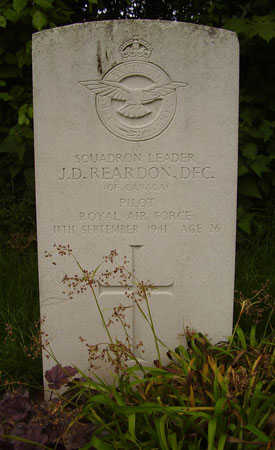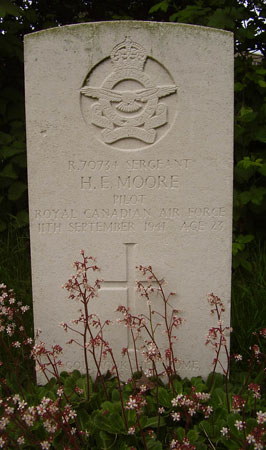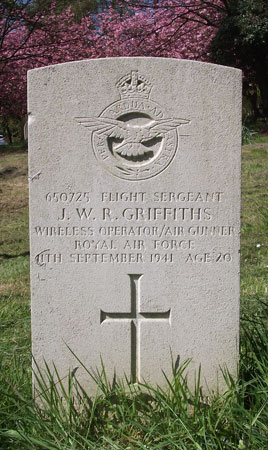Whitley Z6870 at Topcliffe airfield.
On 11th September 1941 this 102 Squadron aircraft crashed at 22.50hrs within Topcliffe airfield boundary while the crew were practicing overshooting during a dual-instruction part of a night flying exercise. An approach to land was made with the flaps and undercarriage down, the approach to land was deemed incorrect to effect a good landing so the pilot attempted to climb away but the aircraft climbed too steeply, stalled and dived into the ground. Three of the crew were killed and two others injured. There is a suggestion elsewhere on the internet that this aircraft was shot down by an Luftwaffe intruder aircraft as they were returning from an operational flight on Frankfurt but this is absolutely not correct. Firstly 102 Squadron did not fly operationally on this date and information given within the crew's casualty file (Air81-9016) states it was a training flight.
Whitley Z6870 had a short history; it was built to contract 106962/40 by Armstrong Whitworth Ltd. at Baginton and was awaiting collection on 6th July 1941. It was taken on charge by 102 Squadron at Topcliffe later the same month and remained with them until the accident on 11th September 1941 when Cat.E2/FA Burnt damage was later recorded.
Pilot (Instructing) - S/Ldr Joseph Damien Reardon DFC RAF (43042), aged 26, of Prince Edward Island, Canada. Buried Topcliffe Cemetery, Yorkshire.
Pilot (Flying aircraft at the time) - Sgt Harold Edwin Moore RCAF (R/70734), aged 23, of Lawson, Saskatchewan, Canada. Buried Topcliffe Cemetery, Yorkshire.
Wireless Operator / Air Gunner - F/Sgt John Walter Ronald Griffiths RAF (650725), aged 20, of Boothstown, Manchester. Buried Worsley Churchyard, Lancashire.
Pilot - Sgt Edward William Smith RCAF (R/62692). Burn injuries.
Air Gunner - Sgt Albert George Frampton RAFVR (1251802). Minor injuries.
Joseph Reardon was born in Charlottetown, Canada in 1915 and studied at Prince of Wales College and the College of the Redemptorist Order at Scarborough
Heights, Ontario before enlisting into the RAF in Augist 1939. He was granted a short service commission into the RAF on 23rd March 1940 to the rank of
Acting P/O on probation. On 13th July 1940 he completed the probationary period and was made Acting P/O and on 23rd September 1940 he was confirmed as a
P/O. He arrived at 51 Squadron on 2nd December 1940 and flew with them until joining 102 Squadron on 6th July 1941. He rose to F/O (War Subs) on 13th July
1941. As Acting S/Ldr he was awarded the DFC (Gazetted on 23rd September 1941) and a press article found on the internet about the award of his DFC
that he was "a steady and dependable captain of aircraft who has shown great courage and devotion to duty. Most of his sorties were completed in winter
months under adverse weather conditions." The burial register at Topcliffe states that he was buried in Topcliffe cemetery on 16th September 1941. Hugh
Halliday's RCAF awards research has been used in compiling this account alongside the London Gazette entries.
Harold Moore's grave at Topcliffe Cemetery. He was born on 30th January 1918 in Moose Jaw, Saskatchewan, Canada and was the son of Sidney Thomas and Elsie Amy (nee Noble) Moore. The family later lived at Lawson, Saskatchewan and he worked on the family farm as a young man. He enlisted for RCAF service on 12th September 1940 in Regina and after training in Canada he was awarded his pilot's wings on 18th April 1941. Prior to leaving Canada he married Eva Rosetta Smith in Toronto on 26th April 1941. He arrived in the UK in June 1941 and after training at 19 OTU he was posted to 102 Squadron on 12th August 1941. The Moore Island in Saskatchewan is named in his honour. The burial register at Topcliffe states that he was buried in Topcliffe cemetery on 16th September 1941 but gives a home address as being Toronto, Ontario (his wife's address ?).
F/Sgt John Griffiths' grave in Worsley Churchyard, Lancashire.



Sgt Smith arrived at 102 Squadron from 10 OTU in early August 1941. In the East Grinstead Hospital records he is recorded as William Ernest Smith. I believe both are one and the same person. Rarely Hugh Halliday's usually superb research appears to have copied some errors from other people's research. Mr Halliday incorrectly links him with 103 Squadron not 102 Squadron and that he survived a ditching of a Whitley on 29th August 1941 on return from Ops to Frankfurt (this did not happen, he was second pilot in Whitley Z6940 that sustained flak damage but it landed safely at base not in the sea). It also mentions that he was the pilot of a Whitley shot down on return from Ops to Frankfurt again on 11th September 1941 (but 102 Squadron did not fly operationally on this night). I would suggest that if the 11th September 1941 date is correct for him being involved in a flying accident then I would link him to being involved with Whitley Z6870 when it crashed at Topcliffe. Smith was injured in a Whitley incident around 11th September 1941 and was initially treated at Catterick Hospital. He sustained burn injuries to his head, hands and legs and also sustained a broken jaw. In March 1942 he was transferred to East Grinstead Hospital and received treatment there, becoming one of the famous Guinea Pig patients. Hugh Halliday states a completely different set of dates though also mentions that he was in hospital at the same time. He claims that Smith was back with 102 Squadron in January 1942 yet also quotes from an interview stating that he was admitted to East Grinstead in the same month and was flying operationally with 102 Squadron from January through to June 1942. What is not in doubt is that he later flew a second tour with 424 Squadron and was awarded the DSO, Gazetted on 23rd March 1945. It appears that some of the incorrect statements may have come from an interview that he himself gave. I would welcome some facts to his time at 102 Squadron.
Sgt Frampton survived the crash of Halifax R9532 at Dalton on 3rd June 1942.
He was made a PoW on 9th July 1942 when Halifax W1107 crashed in Holland.